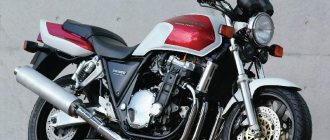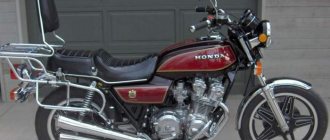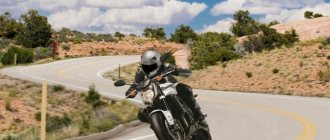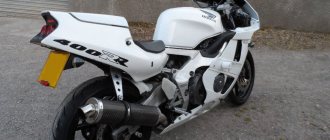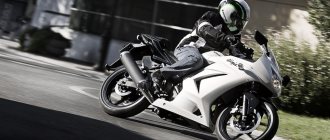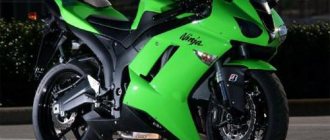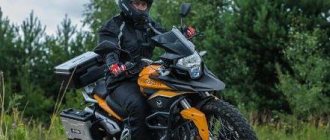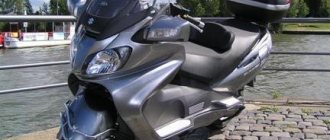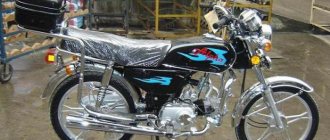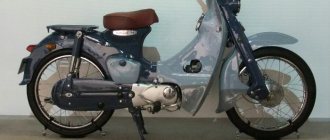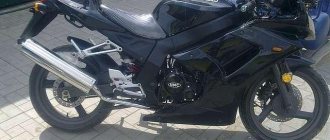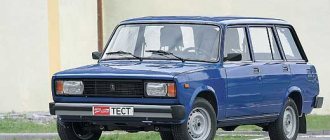| Kawasaki Z1000 (2003-2006) | Kawasaki Z1000 (2007-2009) | Kawasaki Z1000 (2010-2013) | Kawasaki Z1000SX/Ninja 1000 (2011-2013) |
| Kawasaki Z1000 (2014-2016) | Kawasaki Z1000SX/Ninja 1000 (2014-2016) | Kawasaki Z1000 (2017-2020) | Kawasaki Z1000R (2017-2020) |
| Kawasaki Z1000SX/Ninja 1000 (2017-2019) | Kawasaki Ninja 1000SX (2020+) |
Kawasaki Z1000 naked model
was introduced in 2003 as a successor to the legendary Z-series, produced in the 70s of the last century. The model was based on a steel frame, plastic elements from the sports Kawasaki ZX-6R and a derated engine from the Kawasaki ZX-9R with a volume of 953 cm³.
In 2007, the model underwent its first major restyling, receiving an updated appearance and versions with ABS. The front brake is now equipped with radial calipers. Maximum power, compared to the previous generation, is reduced to 125 hp.
2010 was marked by the second restyling of the Kawasaki Z1000 model. The motorcycle gets new plastic and dashboard designs, an aluminum frame, fully adjustable front suspension and monobloc front calipers. The new engine of increased volume (1043 cm³) already produces 138 hp.
Since 2011, the Z1000 line has been supplemented by a plastic version - Kawasaki Z1000SX
. The model is positioned on the market as a sports tourer, which is also offered with touring accessories - panniers, etc.
In 2014, the model undergoes a new restyling, receiving a more aggressive appearance, LED optics and an increased (up to 310 mm) diameter of the front brake discs. Maximum engine power increases to 142 hp. The model also gets a slipper clutch and an Assist & Slipper clutch.
For the 2021 model year, Kawasaki is completely removing the non-ABS version from the lineup and slightly changing the appearance of the motorcycle (mainly paint, logo design, etc.). The rear suspension settings are changing. Performance version appears - Kawasaki Z1000R
. It features Brembo front brakes, Ohlins rear suspension and a proprietary Akrapovic exhaust system (in the R Edition Performance version). The Z1000SX / Ninja 1000SX version also undergoes changes, the main of which is new electronic equipment (KTRC, Power Modes, KIBS, IMU).
In 2021, the Z1000SX / Ninja 1000SX modification receives a new electronic system - KCMF (Kawasaki Cornering Management Function).
For 2021, Kawasaki is introducing a new version of the Z1000SX, which now has a single name in all markets - Kawasaki Ninja 1000SX
. The main changes compared to the previous generation were a new exhaust, changed weight and size parameters and new electronic equipment in the form of electronic cruise control, Smartphone connectivity and a color TFT display.
The 2021 Kawasaki Ninja 1000SX gets a quick shifter as standard.
Kawasaki Z1000 / Ninja 1000SX: electronic equipment
- ABS - since 2007
- KTRC (Kawasaki TRaction Control) 3-Mode - Z1000SX / Ninja 1000SX (from 2021)
- Power Modes - Z1000SX / Ninja 1000SX (from 2021)
- KIBS (Kawasaki Intelligent anti-lock Brake System) - Z1000SX / Ninja 1000SX (from 2021)
- IMU (Inertial Measurement Unit) - Z1000SX / Ninja 1000SX (since 2017)
- KCMF (Kawasaki Cornering Management Function) - Z1000SX / Ninja 1000SX (from 2021)
- Electronic Cruise Control - Z1000SX / Ninja 1000SX (from 2020)
- Smartphone connectivity - Z1000SX / Ninja 1000SX (from 2020)
- TFT Color Display - Z1000SX / Ninja 1000SX (from 2021)
- KQS (Kawasaki Quick Shifter) - Z1000SX / Ninja 1000SX (from 2021)
The main competitors of the Kawasaki Z1000 in the class
:
- Yamaha FZ1/Yamaha MT-10
- Honda CB1000R
- Suzuki GSX-S1000
Brief history of the model
- 2003 - start of production and sales of the model. First generation.
Model
: Kawasaki Z1000 (all regions).
Factory designation
: ZR1000-A1.
- 2004 - no significant changes.
Model
: Kawasaki Z1000 (all regions).
Factory designation
: ZR1000-A2.
- 2005 - the model receives an immobilizer system.
Model
: Kawasaki Z1000 (all regions).
Factory designation
: ZR1000-A3.
- 2006 - no significant changes.
Model
: Kawasaki Z1000 (all regions).
Factory designation
: ZR1000-A6F.
- 2007 - restyling of the model. Second generation
. The model receives an updated appearance, radial calipers at the front, different rear suspension settings and a reduction in fuel tank capacity from 19.0 → 18.5 liters. Maximum power decreases: 127 → 125 hp.
Model
: Kawasaki Z1000 + ABS (all regions).
Factory designation
: ZR1000-B7F + ZR1000-C7F.
- 2008 - no significant changes.
Model
: Kawasaki Z1000 + ABS (all regions).
Factory designation
: ZR1000-B8F + ZR1000-C8F.
- 2009 - no significant changes.
Model
: Kawasaki Z1000 + ABS (all regions).
Factory designation
: ZR1000-B9F + ZR1000-C9F.
- 2010 - restyling of the model. Third generation.
The model receives a new external, aluminum frame, a larger engine (953 → 1043 cm³), fully adjustable front forks, monoblock front calipers and a reduced fuel tank capacity (18.5 → 15.0 l). Maximum power increases: 125 → 138 hp.
Model
: Kawasaki Z1000 + ABS (all regions).
Factory designation
: ZR1000-DAF + ZR1000-EAF.
- 2011 - appearance of the Kawasaki Z1000SX modification (sold in the North American market as the Kawasaki Ninja 1000).
Model
: Kawasaki Z1000 + ABS;
Kawasaki Z1000SX / Ninja 1000 + ABS (all regions). Factory designation
: ZR1000-DBF + ZR1000-EBF; ZX1000GBF + ZX1000HBF.
- 2012 - no significant changes.
Model
: Kawasaki Z1000 + ABS;
Kawasaki Z1000SX / Ninja 1000 + ABS (all regions). Factory designation
: ZR1000-DCF + ZR1000-ECF; ZX1000GCF + ZX1000HCF.
- 2013 - no significant changes.
Model
: Kawasaki Z1000 + ABS;
Kawasaki Z1000SX / Ninja 1000 + ABS (all regions). Factory designation
: ZR1000-DDF + ZR1000-EDF; ZX1000GDF + ZX1000HDF.
- 2014 - restyling of the model. Fourth generation.
The model receives an updated appearance, LED optics, a slipper clutch (Assist & Slipper clutch), an increase in the diameter of the front brake discs (300 → 310 mm), an increase in fuel tank capacity (15.0 → 17.0 l) and an increase in maximum power (138 → 142 hp).
Model
: Kawasaki Z1000 + ABS;
Kawasaki Z1000SX / Ninja 1000 + ABS (all regions). Factory designation
: ZR1000-FEF + ZR1000-GEF; ZX1000LEF + ZX1000MEF.
- 2015 - no significant changes.
Model
: Kawasaki Z1000 + ABS;
Kawasaki Z1000SX / Ninja 1000 + ABS (all regions). Factory designation
: ZR1000-FFF + ZR1000-GFF; ZX1000LFF + ZX1000MFF.
- 2016 - no significant changes. The Z1000SX / Ninja 1000 version is now offered only in the ABS version.
Model
: Kawasaki Z1000 + ABS;
Kawasaki Z1000SX / Ninja 1000 ABS (all regions). Factory designation
: ZR1000-FGF + ZR1000-GGF; ZX1000MGF.
- 2017 - restyling of the model. Fifth generation.
The appearance is slightly updated, the rear suspension settings are changed. A Performance version appears - Kawasaki Z1000R. Versions without ABS are no longer produced.
Model
: Kawasaki Z1000 ABS;
Kawasaki Z1000SX / Ninja 1000 ABS (all regions). Factory designation
: ZR1000-HHF; ZX1000WHF.
- 2018 - no significant changes.
Model
: Kawasaki Z1000 ABS;
Kawasaki Z1000SX / Ninja 1000 ABS (all regions). Factory designation
: ZR1000-HJF; ZX1000WJF.
- 2019 - no significant changes.
Model
: Kawasaki Z1000 ABS;
Kawasaki Z1000SX / Ninja 1000 ABS (all regions). Factory designation
: ZR1000-HKF; ZX1000WKF.
- 2020 - restyling of the Ninja 1000SX version.
Model
: Kawasaki Z1000 ABS;
Kawasaki Ninja 1000SX (all regions). Factory designation
: ZR1000-HLF; ZX1002KLF.
- 2021 - The Ninja 1000SX modification is equipped with a quick shifter.
Model
: Kawasaki Ninja 1000SX (all regions).
Factory designation
: ZX1002KMFNL, ZX1002KMFNN.
Specifications
When you first look at the Ninja 1000, you'll notice its sporty, low-slung stance .
The engineers did a good job and it’s difficult to come up with anything new here.
Well, the low landing is dictated by the strong speed pressure. And it becomes clear why the body of the bike was worked out so carefully.
The spatial tube made of aluminum alloys , which is at its core, effectively distributes the air flow, thus reducing aerodynamic drag.
However, despite this, the handlebars are mounted higher here than on racing motorcycles and this was done in order to increase comfort when traveling at low speeds.
The tilt of the three-position windshield can be adjusted manually. As a result, it always matches the riding style and height of the rider.
As for the seat height, 0.82 m helps to improve aerodynamic properties.
The rear sprocket teeth were reduced by one, the gears were stretched, and the top speed increased.
Now, if the motorcycle is properly equipped with an aerodynamic body kit, you can try to overcome the mark of 200 km/h , which is quite a high figure for a naked bike.
The manufacturer provided the Kawasaki Ninja 1000 motorcycle engine with the following technical qualities:
- Power unit P4, 16-valve, four-stroke, liquid is used here for cooling;
- Engine capacity – 1043 cc. centimeters;
- The highest power at 9600 rpm reaches 101.5 kW (138 hp);
- Compression ratio – 11.8:1;
- Limit torque at 7800 rpm – 110 Nm;
- Starting system - electric;
- The lubrication system operates under pressure, the crankcase is wet;
- Multi-disc clutch;
- The carburetor operates by fuel injection;
- Digital ignition;
- Six-speed transmission, constant clutch;
- Chain drive type.
On the Kawasaki Ninja 600, the pilot can easily climb a couple of steps onto the podium.
To achieve good results, you also need to take care of high-quality equipment, and learn about one of them from our article.
The technical characteristics of the frame also deserve special attention :
- Double-tubular aluminum construction;
- Front suspension – telescopic forks, 41 mm in diameter. The spring load here can be pre-adjusted;
- The front suspension provides 120 mm of travel;
- The rear suspension is horizontal, Back-link type. A gas shock absorber is provided here, and the spring load can be pre-adjusted;
- The rear suspension provides 138 mm of travel;
- The fork is tilted at 24.5°C;
- The front brake is semi-floating double, has a 300 mm petal disc, four piston calipers have radial mounting;
- Front tire size 120/70ZR17M/C (58W);
- The front brake is single-disc, single-piston caliper, 220 mm in diameter;
- Rear tire size 190/50ZR17M/C (73W).
As for the overall dimensions, the manufacturer provided the Ninja 1000 model with a length of 2.1 meters.
The width of the motorcycle is 0.79 meters and the height is 1.07 meters.
If we take the height of the saddle, it is 0.8 meters. The minimum ground clearance is 0.135 meters.
The fuel tank holds 19 liters of fuel.
When fully equipped and with all technical fluids, the motorcycle weighs 228 kg .
Despite the fact that the Kawasaki Ninja 1000 has sporty characteristics, 13.5 centimeters of ground clearance makes you drive carefully.
But still, bad roads can be passed without complications. An almost one and a half meter wheelbase and a 31-degree turn of the front wheel in both directions, together with other parameters, provide this vehicle with excellent maneuverability and ease of control.
Therefore, we can say that the Ninja 1000 is a versatile motorcycle to use.
The engine volume can be compared to the unit volume of a small car . But, taking into account the mass of the motorcycle, it can be argued that its towing capacity is quite high.
The engine's traction characteristics are improved by using long-stroke pistons. Also impressive is the high power of the power unit , which has a great impact on the overall performance of the motorcycle.
The Honda Steed 400 motorcycle has not been produced for a long time, but its popularity has not yet decreased, and this is largely due to the successful design of the motorcycle.
Whether you're an aspiring biker or a motocross guru, gear for this exciting activity is essential.
Reviews
Kawasaki Z1000 reviews:
Expand Collapse
On the plus side, I can say the following: the engine is simply super. High thrust in all ranges, the engine spins up from the lowest revs. If you accelerate sharply from a stop, then from the first wheelie it is guaranteed, you have to load the front to avoid a wheelie. When accelerating, the engine can spin up to almost 10,500 rpm. The acceleration is simply rapid. Despite the weight of 221 kg, steering is very easy. It’s easy to get into a turn, the main thing is not to put pressure on the steering wheel and let the bike steer, then it’s very easy to take turns. The saddle is comfortable, allows you to change position from flat to lying down. At speeds above 140 you already have to lie down, but you can accelerate to 250 if you change the windshield to an optional one. I drove 230 km/h, but I feel that I can go even faster. It is very stable in cross winds, when friends complain about the wind, I ride comfortably. The speedometer turned out to be more convenient than I thought; it seemed that the data would not be readable in bright sunshine, but I can always monitor both the revolutions and other data.
My second bike, the first was a Yamaha R6, I thought I couldn’t continue riding because it was crazy, I had to sell it. I bought a Z 1000 right away in the season, the first impressions were very positive, a very calm motor, like a tractor you can go 60 in 6th gear and accelerate just as quickly. The passes are short, they could have been made longer. .It’s very comfortable to drive, it handles like a bike, the feeling of confidence is very high. Before that, I bought my brother a Z 750-2009, it is much less convenient and harder to drive, it’s not clear why. The Z1000 is a very successful bike for driving around the city; at traffic lights it does 1 right from the start, albeit at 100 meters). Before buying, I thought that it would blow away, there is such a problem, up to 140 ka everything is normal, then it starts blowing, 175 is already an unpleasant sensation, I don’t need any more. I advise all amateurs and beginners who do not strive for parallel dimensions. There were no breakdowns Like a new motor.
I drove this a little, I really liked it, I especially want to note the clarity and intelligibility of the gearbox and excellent brakes, respect!! I didn’t like the digital instrument panel, it’s not clear what’s flashing on it, my opinion is that nothing better than analog dials has yet been invented, but the bike is super, it steers/accelerates/brakes by 5,
I have a 2007 (model 2007-2009), I bought it from Lekha))) thank you by the way. drove 20 thousand, never had an accident, everything works, there was one warranty case - the clutch rod broke... there is no wind protection, it eats up, especially at the bottom, excellent, I like it... I won’t sell it, I’ll change the chain and sprockets, but I don’t know why - I just bought it, everything is perfect
Suspension and braking system
The 2006 model features an improved suspension, thanks to which the bike confidently plows not only smooth trails, but also second-rate roads with holes, humps and potholes. The previous version could cause serious fear in such conditions (as if the engine had not done this before!).
Front 4-piston calipers, which literally bite into two discs with a diameter of 300 mm, are more effective, although they require the use of considerable force. The rear brake responds more readily to the pilot's wishes. Of course, at that time, installing reinforced brake hoses is the optimal solution for this model. The updated model has acquired a pointed tail, under which a dual exhaust is successfully hidden. This, by the way, had little effect on the turbulence of the model.
Relatively small lens headlights with a “tear-shaped” shape and a powerful air intake capable of sucking in a crow appealed to all those who considered the first model too simple and characterless. An attractive highlight is the LED rear brake light and turn indicators.
Appearance, distinctive features
Display determination and confidence - if Kawasaki's designers had such a task, they did it one hundred percent. The presence of plastic panels does not distract from the main elements, but creates angular lines. Here minimalism is combined with functionality: the instrument panel is compact but informative, there is no windshield, below the steering wheel there is a small fairing in which headlights are mounted, reflecting the daring character of the motorcycle.
The gas tank is located quite high, below the level of the steering wheel, its narrowed shape does not interfere with the biker. The seat is designed only for the rider; the rear fender becomes an extension of the saddle.
The engine and main components are made in black. Fairings are manufactured in attractive colors:
- black metallic,
- pearl gray,
- shining emerald,
- green.
The exhaust pipe located on the right side of the driver deserves special attention. Its bizarre forked shape resembles the tail of a robotic fish, blending seamlessly with the exterior of the motorcycle.
Kawasaki Ninja 1000SX On the serpentine
Our area is full of roads that make any motorcyclist a dedicated sport biker.
There are such wonderful winding paths with elevation changes, surrounded by centuries-old pine trees, that willy-nilly you will want to ride along them on a motorcycle that can take turns by force of will. Luckily, the Kawasaki Ninja 1000SX is great for this. And here the engine again shows its best side, delivering exciting acceleration. It gives up after 9,500 rpm, but with such a juicy mid-range, you just don't need to rev it that far. And there's almost no need to shift, but I still enjoyed playing around with the quickshifter. It is not perfectly calibrated, but considering that it is not really needed, thanks to Kava for that too. With such an engine, the quickshifter is a tribute to the sporting, rather than touring, part of the motorcycle.
Kawasaki Ninja 1000SX
All that smooth, easily accessible thrust can easily lead to you gaining too much speed. Luckily, the Ninja's brakes match the engine: a radial master cylinder drives the radial calipers, assisted by a KIBS (ABS) module, to deliver precise, powerful stopping power. Unless, of course, KIBS intervenes, working in conjunction with an inertia measuring device to track the angle of inclination.
Once you pick up speed and start riding in a sporty manner, the Kawasaki Ninja 1000SX clearly demonstrates its weight and the conservative nature of the on-board software developers. KIBS, which uses data from a whole bunch of sensors to provide complete information about what is happening with the bike, seems to be somewhat overreacting in terms of maintaining not only traction, but also suspension balance. Unclear? Now I’ll explain.
Just imagine: you've accelerated your liter-plus sports tourer on a delightfully winding road, you enter a corner and brake in it completely safely - and then KIBS intervenes simply because the weight distribution has changed too quickly during trail braking. Or! Aggressive braking on a straight section can also trigger the ABS, but not because the front wheel has come off (not even close to a breakdown) - but because it seems to the brain that the front suspension has collapsed too much and the motorcycle has lifted the rear slightly. You can trick ABS and delay its intervention by applying the rear brake a moment before braking the front, so that the front suspension collapses shortly before (and not during) the front brake, but it seems a little obscene to me to cheat the smart braking system in order to fully enjoy the ride.
On the contrary, KTRC (traction control) works clearly, smoothly and transparently. Probably, if ABS had several sensitivity levels, like KTRC, everything would be ideal, but it seems that its operating parameters are the same in both Sports and Rain modes. And it cannot be turned off.
Kawasaki Ninja 1000SX
Should I buy or not?
After weighing all the pros and cons, it is difficult to come to any clear conclusion.
The Kawasaki ZZR motorcycle is a good choice for confident beginners who already have some experience riding two-wheeled vehicles, but finding a copy in decent condition is not so easy. Time spares no one, and small-capacity sportbikes, to which the ZZR 400 belongs, are often exploited by their owners completely mercilessly, after which they are put up for sale with a description like “one year in Russia, no accidents, second gear does not fall out.” Therefore, you can consider this model as a possible purchase, but the choice must be approached very carefully. In addition, the Kawasaki ZZR 400 technical characteristics are really good, even if they do not stand out too much compared to their classmates. But here the advantage will be the high prevalence of the ZZR 400 - all its “birth sores” have long been known and “chewed on” on owner forums, and consumables and spare parts for it are plentiful in any large city. The motorcycle is inexpensive to maintain, and almost all service operations can be done in the garage on your own, armed with a standard suitcase with tools. So if you manage to find a “living” specimen, feel free to take it. In the case of the Kawasaki ZZR 400, reviews of its former owners usually contain comprehensive information on maintenance, repairs and problems, so if you are not afraid of the prospect of fiddling with second gear repairs, the Kawasaki ZZR400 will become your faithful friend and reliable transport. In addition, the “Zizer” does not have many competitors who can give you the same sensations of riding a powerful and daring-looking motorcycle for the modest money for which you can buy a live ZZR400.
Specifications
| Power: | 59 HP |
| Torque: | 39 Nm |
| Engine type (cylinder arrangement): | 4-cylinder, 4-stroke |
| Number of cylinders: | 4 |
| Engine capacity: | 399 cm3 |
| Cooling type: | Liquid |
| Transmission: | 6-speed, sequential type |
| Drive unit: | Chain |
| Weight: | 197 kg |
| Tank capacity: | 18 l. |
| Maximum speed: | 190 km/h |
| Wheelbase: | 1430 mm |
